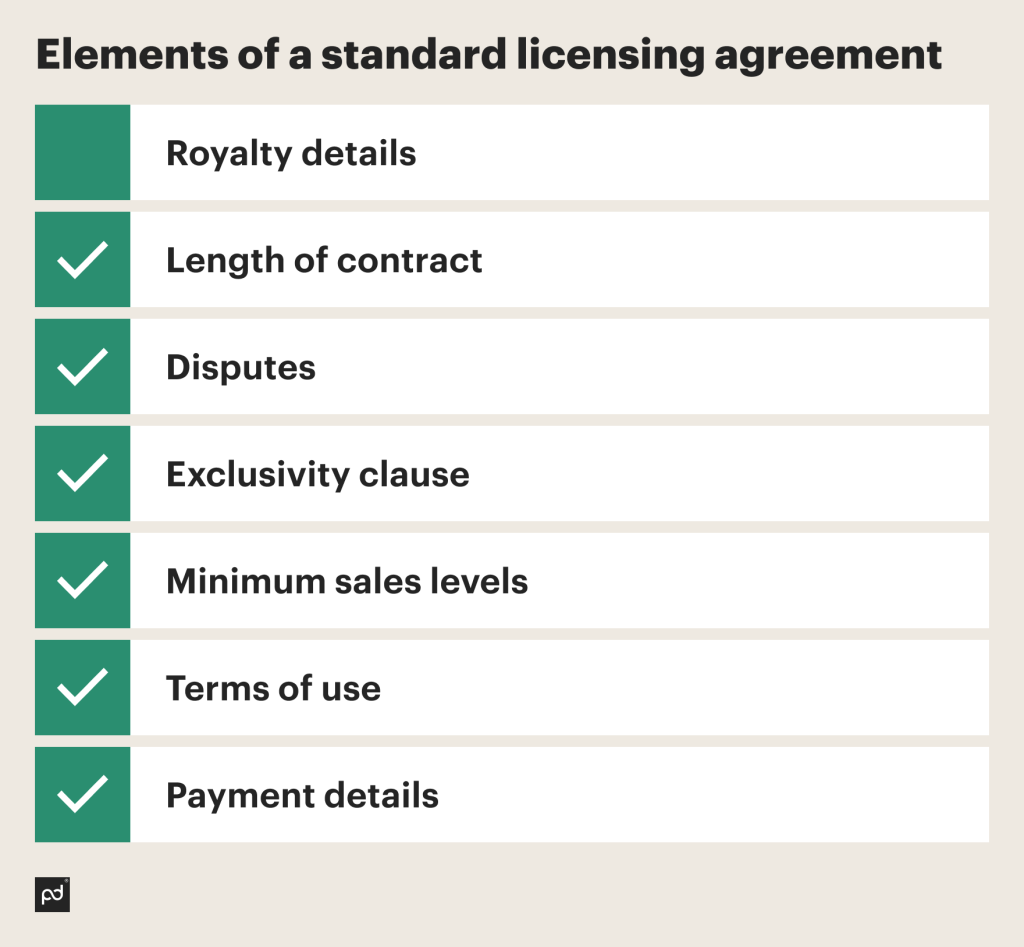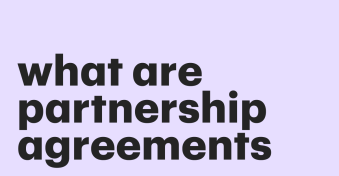Among the types of legal documents that businesses need to deal with on a daily basis, licensing agreements are some of the most universally useful ones to anyone who owns a patent or trademark.
Unfortunately, they don’t tend to come with manuals or guides.
That’s why we’re going to explore all the details pertaining to license agreements.
First, we’ll define what they are, before covering the elements you need to understand so you can learn how to create a licensing agreement of your own.
After that, we’ll cover the advantages and disadvantages that these agreements carry.
What is a license agreement?
At its most basic, a licensing agreement is a contract between two parties, one of which owns a patent (or a brand, trademark, or other type of copyright).
The agreement outlines exactly how the other — non-owner — party is allowed to use the owner’s copyrighted material.
In simple terms, it’s a formal document that sets out how you can use someone else’s trademarked item or idea, with their permission.
License agreements are designed to establish fair terms that let you earn money while using someone else’s property.
We’ll discuss the uses of license agreements shortly, though, so stick around to learn more.
To help you get a better idea of what a license agreement looks like in real life, we’re going to take you through some of the most important items that make one up.
Elements of a standard licensing agreement
While every licensing agreement is unique, they tend to have a lot in common.
This is what makes samples like a software license agreement template, which set out precisely which items you’ll have to fill in, so useful.
With that said, the following elements are common to almost every kind of licensing agreement out there:

Royalty details
When you use someone else’s copyrighted material, you always need to offer them something in return.
Otherwise, they would have no reason to let you earn money off something they own.
A good licensing agreement should establish the exact royalty rates you’ll both be agreeing to.
Of course, these need to be agreed to before the agreement is even drawn up.
Royalty rates will generally depend on how much money you’ll be earning, as well as how large of an audience you’ll be marketing to.
In the case of music, movies, or similar media, the length of the piece also influences the royalty rates.
Since they’re affected by a wide variety of factors, royalty rate calculations would also be included in your licensing agreement.
In other words, anyone should be able to look at your completed royalty agreement template and work out how much the license holder will be earning in royalties.
Length of contract
When you’re lending your ideas, brand, and/or trademark to someone else, you’ll generally want to have some idea of how long they’ll be using your property for.
This is why the length of your contract needs to be written into your licensing agreement.
Some agreements might tend towards shorter contract lengths, while others could last for years.
The most important thing is to establish realistic and fair terms that will make sense for the entire duration of the contract.
Renewals
We’ve just covered the fact that license agreements are very rarely, if ever, indefinite.
This is why renewal terms are often included in new licensing agreements.
In some cases, these conditions will be more specific than others.
Highly sought-after trademarks, for example, might only grant renewals if a number of conditions are met.
On the other hand, brand-new software developers might be more eager for their products to be used widely, so they would agree more readily to lenient renewal terms.
Regardless of the terms themselves, renewal conditions are important to include because they make the process of renegotiating an agreement much, much easier.
This saves both parties time and effort.
Disputes
Any agreement between two or more people is always going to create the potential for conflict.
That’s not a bad thing, provided you’ve got the tools to navigate it.
For this reason, it’s always a good idea to write down exactly what’s going to happen if the parties signing the licensing agreement disagree on anything later down the line.
The dispute clause might point to pre-approved resolutions for likely topics of dispute.
It might also explain what the procedure should be if neither party is able to meet the other halfway, or if the other resolutions don’t work. Either way, it should help the agreement progress smoothly.
Exclusivity clause
Anytime a copyright holder chooses to let someone else use their copyrighted material, they’ll have to explain upfront whether that use is exclusive.
To phrase that another way, they’ve got to state clearly whether the party they’re coming to an agreement with is going to be the exclusive party that’s able to use the copyrighted content.
This clause binds and affects both parties.
So, in the event of full exclusivity being granted, neither the copyright holder nor the party they’re signing with can let anyone else use the material in question.
This protects both parties by strictly limiting who can make use of it.
Minimum sales levels
In order for a licensing agreement to be profitable to the person granting the license, they’ve got to earn enough money from the deal.
That can only happen with sufficient royalties being brought in, or with enough sales being made.
This means that the agreement itself has to state how many sales the new license holder has to make.
If the license holder doesn’t meet this requirement, the agreement itself may be terminated, or a fee may be owed to the license grantor.
Terms of use
License agreements essentially represent a collaboration between two separate parties.
Each will have their own brand identity and values, which must, to at least some extent, overlap.
The terms of use are a legal way to formalize that overlap.
They explain exactly what may (and may not) be done with the licensed material.
For example, if a photograph is being licensed, the copyright holder might be fine with that picture being used for commercial advertisements, but not for anything that advertises drinking, smoking, or gambling.
Payment details
Who will be paying whom, with what regularity, and in which ways?
Your licensing agreement needs to be explicit about payment agreements.
This prevents confusion later down the line, and stops either party from being able to claim that the other did not pay them correctly.
What is the purpose of a licensing agreement?
Now that we know what a licensing agreement is, as well as what sorts of items you’d typically find in a copyright license agreement template, it’s time to look at the reasons why you’d want to use one in the first place.
Here’s a quick rundown of the top reasons why people and businesses use licensing agreements:
For clarity
Licensing agreements can be lengthy, and for good reason.
They’re designed to clarify every aspect of a license, so neither party is left with any questions about how it’s going to be used.
That clarity is essential for proper business planning, especially for companies that want to make sure their future is more profitable than their present.
To extend their reach
A copyright holder might not be able to reach a large audience on their own, particularly if they’re a single individual without a massive following, or if they’re a brand new company with few connections.
Licensing agreements let them keep ownership of their ideas or products while reaching more people.
For collaborations
When two parties want to work together on a collaboration, they can rarely just jump in without risking complications during the project.
A licensing agreement helps them set out the exact terms of their joint work, so everyone involved knows exactly what’s going to happen and how.
To establish legal groundwork
Businesses always need to know they’ve got a legal leg to stand on, particularly where other parties are concerned.
Licensing agreements are purposely created to be legally-binding for this reason.
Advantages of a licensing agreement
A license agreement can be a great idea. We’ll show you why with a quick list of the top benefits of using one:
ROI
The more often your license is used, the more royalties you can make.
On the other end of things, the more use you can make of someone else’s licensed ideas or products, the bigger the boost to your bottom line.
This yields mutual ROI, and serves as a major advantage of using a licensing agreement.
Legality
As mentioned above, creating a legal precedent gives you a foundation to fall back on in the event of disagreements in the future, thereby lending extra security.
Ease of use
While some legal documents can be confusing to the average layperson, licensing agreements are generally quite clear about their terms.
This means they can be checked easily, ensuring all parties comply with them at all times.
Renewability
We’ve highlighted the importance of a renewal clause because it’s so useful.
A licensing agreement is typically written to be easily or quickly renewed, so both parties can keep working to their mutual advantage.
Lowered financial risks
By relying on a promising concept or brand, particularly one that already has a dedicated audience, businesses can increase their profits at limited risk to themselves.
That’s because the market already exists and is already engaged.
All a savvy business has to do is capitalize on that fact.
Disadvantages of a licensing agreement
Unfortunately, no good thing can exist without its downsides. These are the downsides you should know about before you look into how to create a licensing agreement:
- Change of control over the intellectual property from the licensor to the licensee. This might not actually come with any tangible negative repercussions, but it can still be uncomfortable or unpleasant to some licensors.
- Limits. Licensees can’t use the copyrighted property outside of the exact terms set out in the agreement, meaning that the ways in which they can capitalize on the property are limited to at least some extent.
- Dependency. The property owner has to wait and see what their licensee does with their copyrighted material. That can cause distress, particularly if the licensee isn’t communicative or doesn’t explain their process well.
How to create a licensing agreement
In many cases, the actual creation of a licensing agreement doesn’t fall to the people who will be signing it.
Instead, that responsibility often goes to the legal teams that both parties signing the agreement rely on.
However, it’s important to note that not everyone has the resources to pass off a task like this to a legal department.
Additionally, not every company wants to use their time or money that way when they know they can create a licensing agreement on their own.
For those people, we highly recommend using a licensing agreement sample.
This shows them exactly which items to include, and how the agreement should be set out.
Once the agreement has been drawn up, a legal professional can always look over it retroactively and tidy up any issues.
To go one better, you could always take advantage of an all-in-one contract management software solution and make sure all your bases are covered.
In addition to templates for licensing agreements, PandaDoc offers dozens of other types for numerous other situations.
Create and customize error-free contracts in the blink of an eye.
Licensing contract template
Depending on the industry you work within, the typical looks of a licensing agreement form can vary greatly.
For example, a photo licensing agreement template will typically look different from a music licensing contract sample, which in turn won’t look the same as one designed with software in mind.
When you’re creating your agreements, make sure the template you’re using accurately reflects the needs of your industry and business.
Let PandaDoc help with your licensing agreements
Now that we’ve covered the basics on how to create a licensing agreement, it’s time to think about putting your own agreements together.
Of course, that’s significantly easier with the help of templates, which PandaDoc has in spades.
PandaDoc templates are available for all kinds of licensing agreements, saving you time and hassle.
All you need to do is fill in the appropriate details, and you’ll turn a template into a legally binding document in no time.
Sign up for a free 14-day trial with PandaDoc now to let us start helping you create the best possible licensing agreements and more!
Disclaimer
PandaDoc is not a law firm, or a substitute for an attorney or law firm. This page is not intended to and does not provide legal advice. Should you have legal questions on the validity of e-signatures or digital signatures and the enforceability thereof, please consult with an attorney or law firm. Use of PandaDocs services are governed by our Terms of Use and Privacy Policy.


